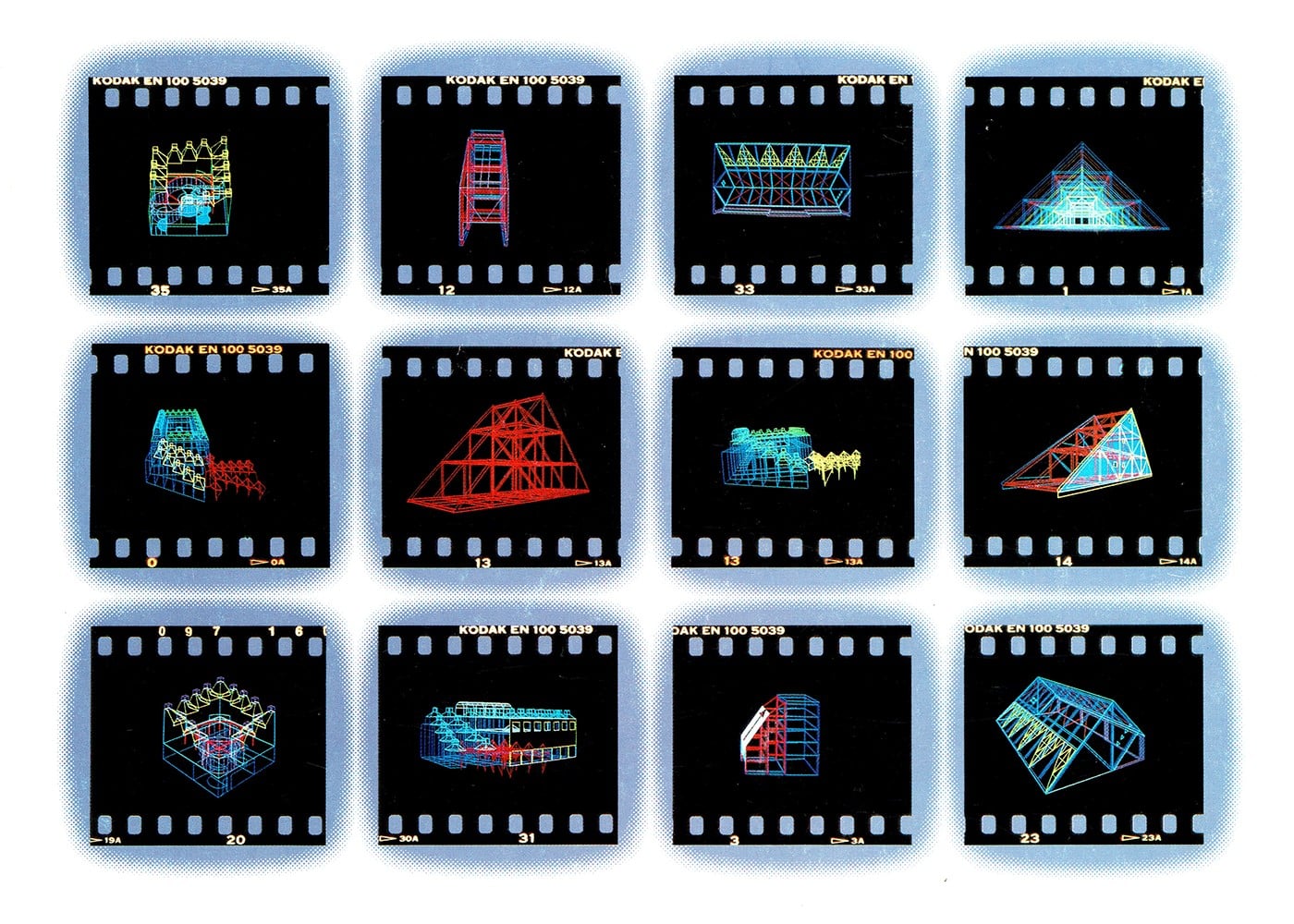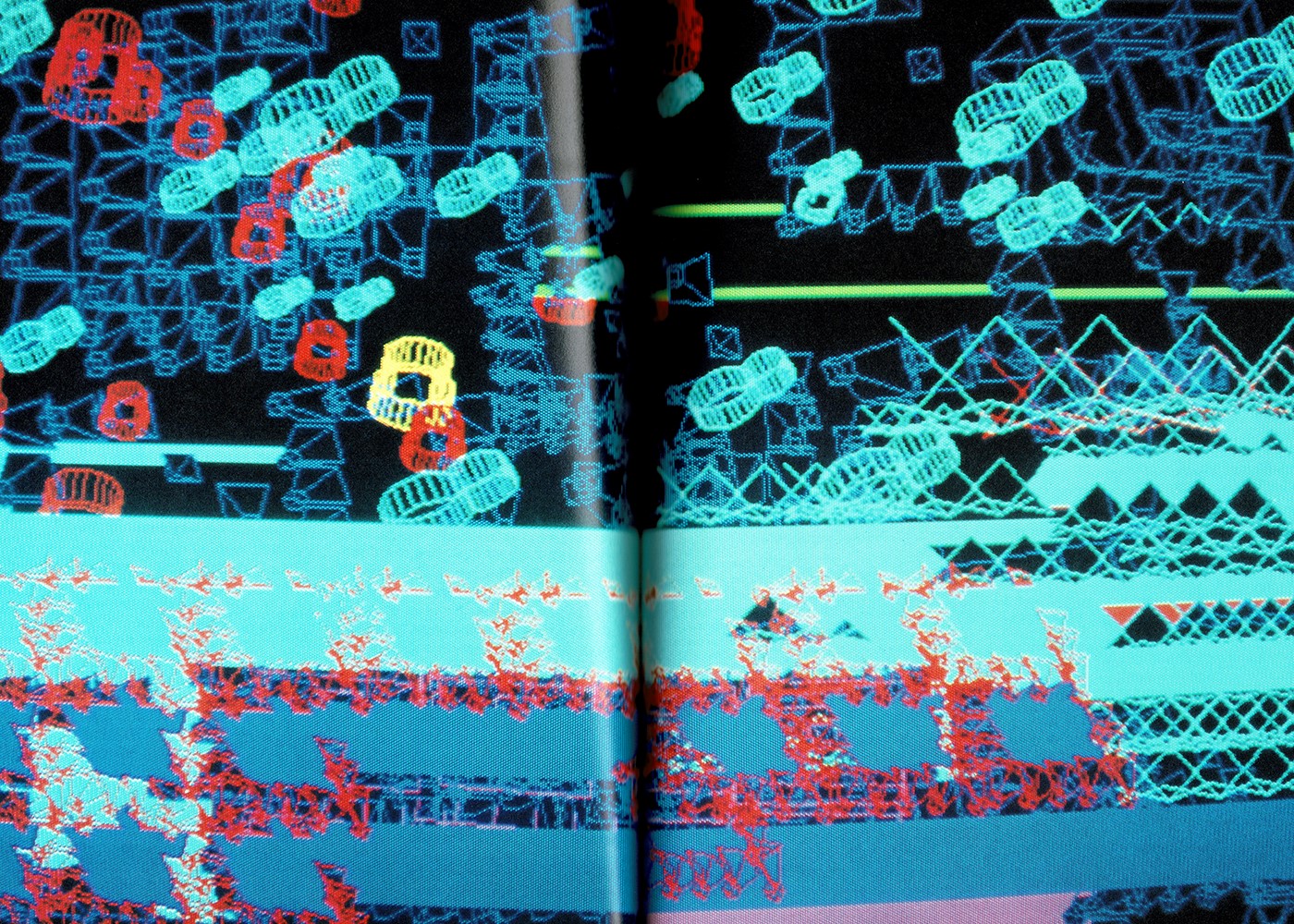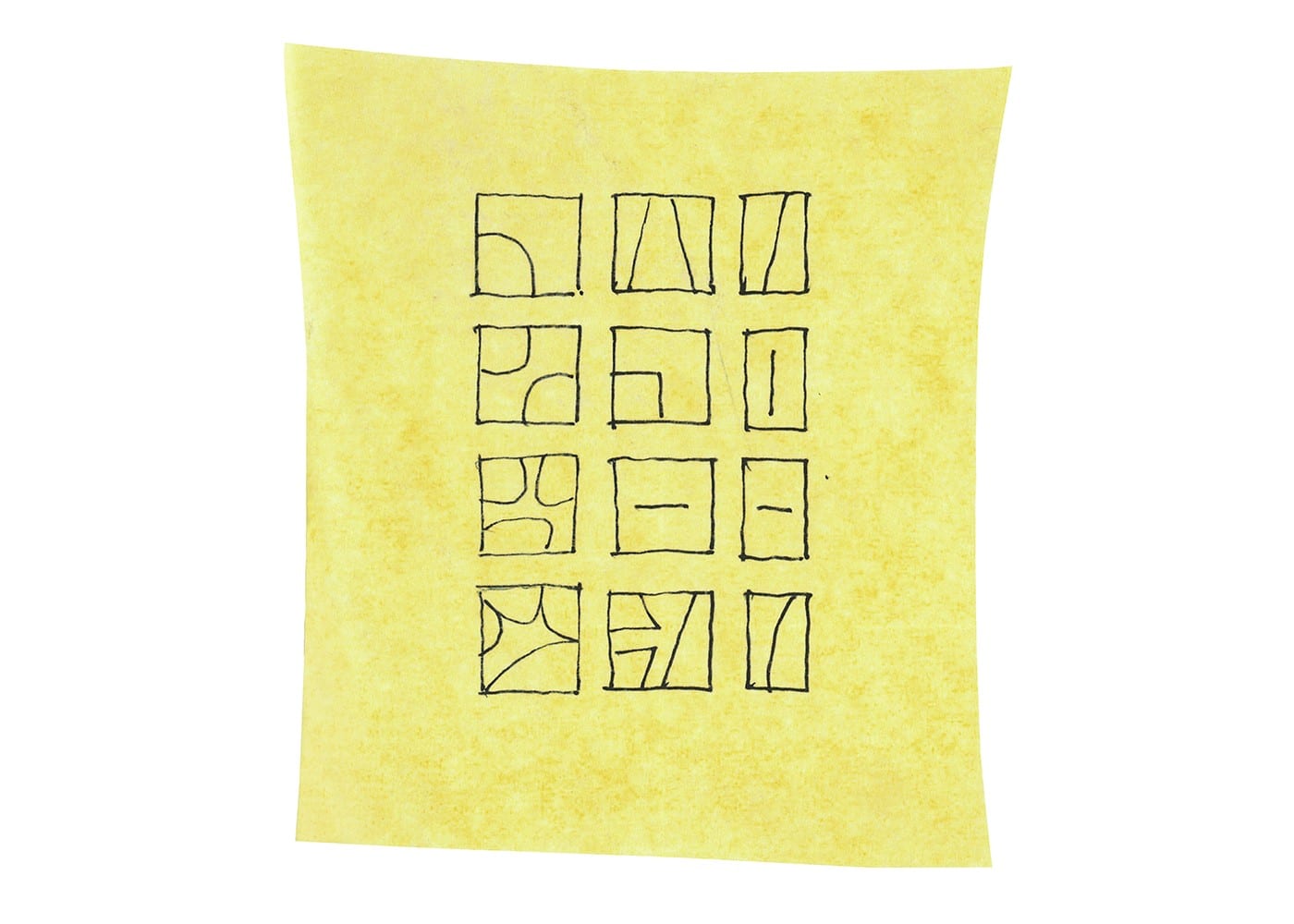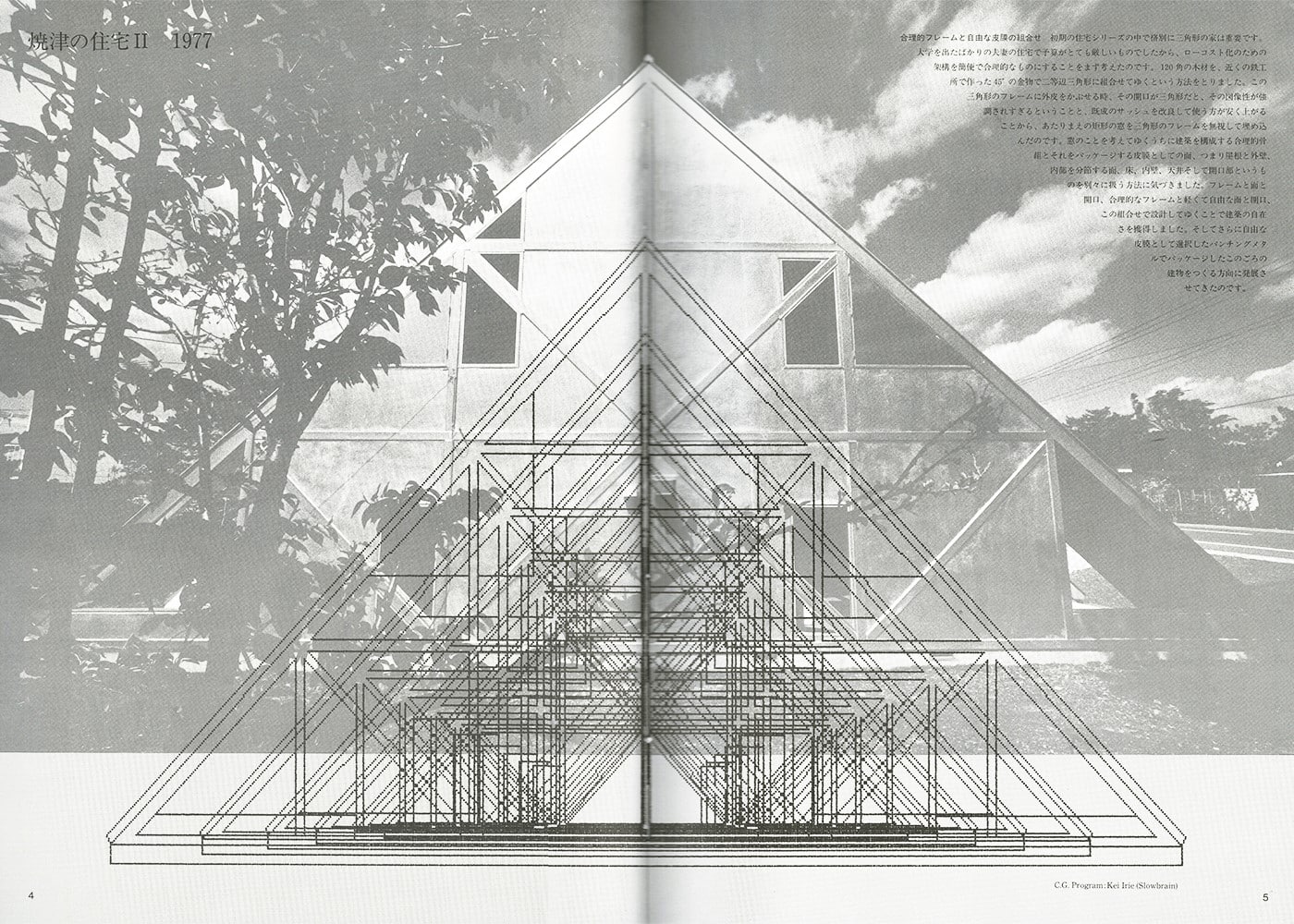Writing Prize 2021: Itsuko Hasegawa, Capturing an Infinite Distance

Negatives
Of the 120,027 items included in the archives of the Centre Pompidou in Paris, 16,010 are part of the collection called ‘Architecture’, and 22,877 are filed as ‘Negative film’. Astonishingly, only one entry sits in both: ‘Ensemble de 12 négatifs couleur (4 pour le projet Bizan, 6 pour le projet Yaizu 2 et 2 pour le Mix)’. [1]
The author of these unusual negatives is the Japanese architect Itsuko Hasegawa, and the work dates from 1985. The fact that an architect experimented with photography is of course not unusual, and perhaps even to be expected. But what makes Hasegawa’s exploration intriguing is the way in which she uses the graphic possibilities of photography to reflect on her own creative practice. The negatives shown in this image are long-exposure shots of a computer screen displaying 3D models of her projects. At the time, this was the most efficient way to immortalise computer-generated models. Her mentor, Kazuo Shinohara, had also been experimenting with the same technique in unison. But where Shinohara used the extracted images in order to create prints, which were intended to be appreciated like pieces of abstract art, it seems Hasegawa thought of the negatives as objects that conveyed the formal principles of the project and were of similar importance as hand drawings and physical models. [2]
In a 1985 issue of Space Design magazine, which was completely dedicated to her work, Hasegawa places the negatives on the cover: not the images ‘contained’ in the negatives, but a photograph of the negatives themselves, complete with the markings of the brand, model and technical specifications. Perhaps Hasegawa’s suggestion is that these negatives should ideally be experienced in vivo like her physical models. Instead of seeing them as inert printouts, one should see the light going through them, further mediating the visual effect of the computer screen.

Entropy
Following a similar theme, the magazine also includes full-spread close-ups of some of the negative films, as if one was looking through them with a magnifying glass. These zoomed-in images are heavily pixelated and almost psychedelic in effect, with a whirlwind of vibrant blues, yellows, pinks, and reds spiraling from the blackness of the page. The different elements of the projects are unleashed and copy-pasted throughout this virtual void. The result is a chaotic visual landscape, which only alludes to the context in which the buildings are engulfed. The project and the city are cut from the same cloth.
The twelve negatives include representations of five projects. [3] Four of these projects were either freshly finished or otherwise being built when the negatives were published in 1985. The remaining project is House in Yaizu 2, designed in 1975 and built between 1976 and 1977. This is an unexpected inclusion given the timeline of the other four projects, but somehow perfectly completes the ensemble.
House in Yaizu 2 is a low-cost three-dimensional grid of wooden elements, contained within a right-angled triangular section, and finished in metal roofing and silver paint. Floorplates and walls are inserted within the grid according to necessities, and in a manner that allows for future changes. Perhaps it is the primacy of this spatial framework that led Hasegawa to have another look at this project when she started to develop buildings using metal frames. Indeed, like these nascent works of the mid-80s, and unlike her other early projects of the 70s, House in Yaizu 2 is primarily a rational construction system, a frame for domestic life made of equal and repeated elements.
It is as if computer modeling finally allowed Hasegawa to depict and archive that project, almost a decade later. As Milan Kundera noted in 1986, ‘today one can make music with computers, but the computer has always existed in the head of the composers’. [4] Similarly, the computer and its possibilities have maybe always existed in Hasegawa’s head. For her, its role was perhaps not exactly to compute, or to ordinate (as suggested by the French and Spanish words for computer, for instance), but rather to measure the distance between the projected and the physical, between the rational and the chaotic modes of design with which she was experimenting.
A Long Distance
Hasegawa’s other early projects of the 70s, however, are looking for the ‘inorganic’ instead of perfect constructive systems. They are houses with very compact volumes and prosaic demands, revolving around one central theme: distance. The idea is that a specific handling of the plan can increase distances within a house, and therefore challenge conventional forms of inhabitation.
With the idea of ‘a long distance’ I introduced a means of separating human beings as subjects from the physicality and muteness of architecture, thus keeping them both autonomous. My aim was to let the two entities that have no dialogue come close and react to each other, which would hopefully generate a new meaning. [5]

She records these various experiments on distance in a hand drawing from 1977, on an oddly shaped piece of yellow paper. The drawing is a set of abstracted plans, reduced to rectangular outlines and to a few lines representing the main walls that organise the ‘interior distance’. A handful of these plans correspond to actual projects, while the other ones are essentially options – an attempt to exhaust the possibilities of the ‘long distance idea’, even if they do not correspond to anything being built. [6]
The plans become a set of ideograms. As drawings, they refuse both the romantic approach of the ‘inspired sketch’ and the accuracy of measured drawings. They function as a hinge between the idea (‘a long distance’) and the concrete requirements of the building.
House in Yaizu 2 was omitted from this exercise because its plan is less important than its section, but also because other requirements informed the project more directly. She writes that ‘just deciding where to put the water system demanded all her attention’. [7] But from these constraints, she conceived a simple and crystalline system – a more direct way to approach the ‘autonomy’ and the ‘dialogue’ she mentions above. So, no need for a drawing to necessarily act as the ‘hinge’ between idea and matter. The ideogram for House in Yaizu 2 could hardly be drawn with two or three pencil lines, and it certainly could not start with a dry rectangular outline.
The Infinite
Perhaps the functional substitute for an ideogram of House in Yaizu 2 is the upper-right 1985 negative, which shows the triangular house in frontal perspective, and extruded horizontally away from the viewer into the horizon, suggesting an endless repetition of her construction system.


In 1986, one year after making the negatives, Hasegawa was invited to publish an issue of another magazine titled Space & Concept. Its uniqueness among the vast array of Japanese publications on contemporary architecture of the time was that each issue was dedicated to a single practice and that each architect was responsible for the curation of the content and its graphic layout. Hasegawa’s issue opens with a spread that shows a frontal photograph by Mitsumasa Fujitsuka of the rather enigmatic triangular facade of House in Yaizu 2. Hasegawa overlays the lines of that crucial negative on the photograph, which shares the same viewpoint. The spread is completed with a small descriptive text, entitled ‘Free Film on the Rationalized Frame’, forming an ensemble vaguely recalling Joseph Kosuth’s One and Three Chairs.
Like an X-ray scan, the negative reveals the interior of the project, affirming its continuity with the pattern of the facade, but also shows the house to, in some way, be merely a fragment of a conceptually infinite system. This infinity, however, is not intended as some form of future utopia, simply the affirmation of the possibilities of a new construction logic. In Hasegawa’s world, the chaotic light of the negative films is the counterpart to the clear black lines traced on paper, the other side of a single pursuit for that ‘dialogue between human beings and architecture’. While the hand describes the geometric strategies, the computer and the camera underline the tensions, simultaneities, and fragilities of that dialogue. They seek the legibility of the opaque matter.
Ahmed Belkhodja is a Swiss architect and co-founder of fala atelier in Porto, Portugal.
This text was selected as the winning entry in the General Archive category of the Drawing Matter Writing Prize 2021.
Notes
- https://www.centrepompidou.fr/fr/ressources/oeuvre/cj5X8ag
- Shinohara seems to have been first to publish photographs of computer screens in 1984. After completing his House in Yokohama, he places a framed printout of one of them (representing the house itself) in the center of the tatami space like an icon.
- This means that the title of the Centre Pompidou entry is either incomplete or wrong.
- Kundera, M, L’art du roman, (Ed. Gallimard: Paris, 1995), p.85.
- Hasegawa, I., transl. Kayoko Ota, An exercise of formally structuring a house, (e-flux.com: 2020).
- The top 3 plans correspond to (l-r) House in Kakio (1977), House in Kamoi (1974), and House in Midorigaoka (1975), the right-hand-side one of the second line loosely relates to the first House in Yaizu (1972).
- Hasegawa, I., Of Seas and Nature and Architecture, (Shokokusha: Tokyo, 2012) p.89.
